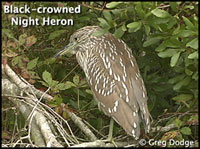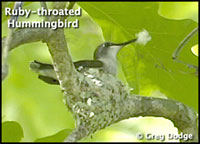Top Photo: Green heron eyes blue dasher (dragonfly).
A Black-crowned Night Heron was seen on two separate days at the beginning of the period. The bird was in immature plumage and had not yet acquired the “black crown” of its common name. It may take 3 years to acquire full adult plumage. Black-crowned Night Herons are active at night and sleep the day away, so it may still be about tucked in out of sight amongst the willows. This is an unusual sighting for the Wetlands.
More typically, a Green Heron and a Great Blue Heron tried their luck at catching a meal from the Wetlands. Tadpoles and fish are what they’re after, although a passing dragonfly, small snake or a frog also fit the bill.
A Spotted Sandpiper was seen briefly at the start of the month, no doubt just stopping by on its way north.
The Red-shouldered Hawks that frequent the area often hunt for frogs and snakes while perched among the willows of the Wetlands, although they sometimes perch in clear view out on one of the snags in the middle of the wetlands. Often very loud birds while soaring overhead, when perch-hunting they usually remain silent. So, you have to keep a sharp eye out for them. The hawks apparently do well in their hunting endeavors. I’ve seen a Red-shouldered Hawk carry away a careless frog on more than a few occasions.
Red-winged Blackbirds, Gray Catbirds, and Common Yellowthroats are singing around the Wetlands and a Wood Thrush continues to sing from the woods above the Wetlands, just as you enter Catch the Wind.
A Great Crested Flycatcher was heard and seen for the first time this season at several locations and a Yellow-breasted Chat was both heard and seen behind the bird feeder area in Catch the Wind.
An Eastern Kingbird was seen perched on a willow in the Wetlands during the latter part of the period. It didn’t stick around.
While standing on the boardwalk watching Eastern Phoebes catch flying insects (the Phoebes nest under the boardwalk), I noticed a Ruby-throated Hummingbird carrying fibers (the cottony seed “fluff” from the willow trees) up into the trees above the boardwalk. The bird’s flight led to a small branch in a White Oak tree where the bird added the soft, fluffy fibers to its nearly completed nest.
Fortunately, I happened to have my video camera with me. A few lucky Museum guests were able to get a glimpse of the bird sitting on the nest by looking through my camera viewfinder. We’ll keep tabs on that one for any future developments.
Two Northern Rough-winged Swallows were seen over Catch the Wind and the Wetlands. I suspect they’re nesting nearby. They nest in burrows in banks or cliffs but also drainpipes and holes and cracks in walls. One place to see them with some regularity is in the rear of a strip mall. Drive behind a large strip mall and you’ll likely see Rough-winged Swallows hawking insects around the shipping/receiving areas behind the mall. There are many holes, projecting pipes and little nooks for the swallows to nest in on the walls of the buildings. I’ve even seen them make nests in the trailers or containers which are usually parked behind the malls. I’m anxious to see if they’ll nest in one of the many holes and cracks on the old rock quarry wall at the back of the Black Bear enclosure.

